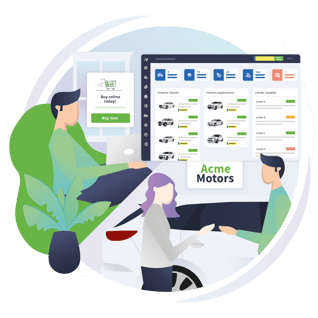How to connect your online and showroom sales processes
Connected Retailing
At its core, Connected Retailing is a simple but persuasive idea. It is the concept of connecting the online and showroom sales processes. Connecting consumers to retailers and lenders, and connecting the vehicle and financial purchase through all stages of the buying journey.
But why is this important?
Buyer expectations have leapt forward, and what was once a reluctant motor industry engaging with the online world has shifted to a sector that needs to embrace change while navigating the complexities that come with vehicle retail.
As the lasting shift towards e-commerce continues across the economy, many sectors have completely transformed how they interact with their customers. The number of people shopping online globally is steadily increasing and many industries now use digital solutions to improve their customer experiences, creating online journeys that keep consumers engaged.
But not all buyers want to buy online. Many still value the expertise and support that retailers can offer.
So how do you cater to all buyers, whether they want to buy online, in-person, or dip in and out of the digital sales journey?
With a car sales software designed to provide consumers with compelling online shopping experiences that work just as well for customers when they enter the showroom, maximising outcomes for the retailer and customer across both the online and physical sales channels.
The concept of Connected Retailing is divided into three distinct stages:
Engagement → Conversion → Transaction

1. Engagement
The engagement stage covers all aspects of the consumer's research journey.
90% of consumer vehicle purchases now start with online research, and being able to engage consumers at the earliest stages in the buying journey has become a differentiator between successful and unsuccessful online retailers.
The goal at the engagement stage is to help web users find what they’re looking for, in an organic and natural way that doesn't make them feel pigeonholed into specific purchase routes.
2. Conversion
The conversion stage is where consumers begin to share and demonstrate interest in specific products and services.
More than a third of consumers are willing to self-serve much of the vehicle buying journey, as long as the online tools available provide a valuable return for the consumer that compliments the purchase journey.
These include steps that provide additional information to the consumer such as the affordability of a vehicle, and the consumer's likelihood to be approved for finance.
The conversion stage is where retailers can generate valuable automotive finance leads as consumers interact with their online calls-to-action, sparking their initial interest in the vehicle and enabling retailers to chase leads proactively.


3. Transaction
The final stage in the Connected Retailing journey is the transaction stage. This is where interested consumers actually buy the vehicle, connected to a retailer who is able to support and facilitate the entire process through an innovative dealer management system.
Vehicle transactions are complex, and having a dealer platform that enables deals to be created the same way online and in the showroom unlocks an abundance of efficiencies for both the retailer and consumer, and helps meet the needs of all types of buyers.
Consumers want simplicity and retailers want to remain in control and having a system that meets both parties' needs is the ethos that created Connected Retailing.
Traditional technology has placed limitations on the online vehicle sales journey, which has in turn, hampered sales potential.
Vehicle sales are complex. There are many challenges when it comes to retailing vehicles including negative equity, part-exchange, settlements, add on products and negotiations. But consumer demand for online retail is on the rise and consumers will migrate toward more digital journeys as and when they become available.
 Retailers require a dealer management system that can easily switch between online and showroom sales models; a single dealer platform with the capability and tools required to manage, operate, and grow online and showroom sales as a single entity. But many are stuck with what we call online retail 1.0 a linear approach to retail that doesn’t work for the automotive sector.
Retailers require a dealer management system that can easily switch between online and showroom sales models; a single dealer platform with the capability and tools required to manage, operate, and grow online and showroom sales as a single entity. But many are stuck with what we call online retail 1.0 a linear approach to retail that doesn’t work for the automotive sector.
Many people think online retail will follow a standard linear conversion model. But the journey is divergent with customers finding their own paths to purchase. While online retail is increasing and in-person shoppers are decreasing, the biggest growth is seen amongst what we call the channel hoppers – those who will begin the purchase journey online but switch to a traditional physical experience at some point along the way and may continue to switch between digital and physical channels until the purchase is complete.
The right car sales software can help retailers cater to all customers, no matter how they want to buy. It is about empowering the consumer to transact in the way they want to – whether that is online, in the showroom, or a mix of the two. And it is about providing retailers and consumers with online car buying software that translates into streamlined showroom experiences. And the dealer management systems needed to do this is accessible and cost-effective for all retailers.
By connecting the online experience with the in-store experience, dealers now have a unique view of the customer journey and the associated sales process.
The ability to connect the dots between the online and in-store experience is unlocking many efficiencies and providing retailers with the ability to create a seamless and effortless, high-quality customer experiences that occur within and between contact channels.
Retailers need to view their showroom and their online channels as one big sales floor.
Even before the significant acceleration in online consumer activity, retailers have tended to treat the two channels as completely different spheres of business.
This has resulted in an industry that is out-of-touch with modern consumer needs, left behind by the rest of the e-commerce world, and one unable to quickly adapt when significant factors impact the market.
By enhancing the online experience and building a relationship between the online and showroom sales channels, retailers can gain access to consumers much earlier in the buying journey, by connecting with them during the research stage.
The benefits of enhancing the online experience is that it can drive more traffic into the showroom.
By providing an experience that encourages consumers to interact online, retailers can turn their website into an automotive finance lead generation machine, one that fulfils consumer needs and in return delivers highly-qualified leads, from consumers who are in-market and ready to buy.
Established dealers have an on-the-ground presence, something that gives them a significant advantage over digital disruptors in several ways, so much so, that the largest of whom have started to roll out their own physical locations to act as customer centres.
This boots-on-the-ground advantage gives existing retailers a much smaller barrier to entry into the online world.
The costs associated with providing an online experience comparable to the most well funded digital retailers are considerably smaller than those associated with expanding to new physical locations.
As new car sales software systems develop, the costs associated go down, and with the new Software as a Service (SaaS) subscription model adopted by most technology providers, there are no inflated upfront costs to overcome.
One of our key messages to the dealer sector is that you can be a disruptor too, and offer everything that we are seeing from extremely well-funded, high-profile newcomers.
We believe the real question retailers need to be asking themselves is can they afford not to enhance their online presence in a way that compliments and drives interested consumers into the showroom.
The right dealer platform is key to encouraging consumers to take the next step. The right calls to action on your website can accomplish many things, like generate automotive finance leads, or produce a list of interested people to call. Including calls to action that are dedicated to drive people into the showroom are an absolute must.
A recent paper we published looked at the three types of buyers, and by far the most dominant group is the channel hoppers, buyers who start the journey online and finish in the showroom.
These people want an online experience that’s convenient when it suits them, but also leads them to all the expertise and in-person experience that can only be found once they step into the showroom.
Having the right car sales software in place that not only creates opportunities, but encourages visitors to self-direct themselves into the showroom will be invaluable to vehicle retail over the coming years.
Technology capable of meeting the diverse needs of buyers moving seamlessly between physical and digital worlds will soon be essential to the operation of any vehicle retailer as buyer expectations continue to evolve.
Websites and showrooms need to be connected as the internet changes from a research tool into a method of acquisition.
A significant player in the world of online experience, Google, has now stepped into the automotive space, with a new advertising platform dedicated to driving interested consumers onto auto retailers’ websites.
This change will see a significant shift in the way people shop for cars, as Google’s clever local search algorithms will do a lot of the heavy lifting on behalf of the auto retailer, by only showing its users the vehicles that match their search criteria that are within a set physical distance.
As retailers take advantage of the new platform, it is inevitable that there will be a jump in their website traffic, however, if the industry continues to lag behind the rest of the economy in the adoption of effective digital technology, they won’t be able to capitalise on the increased visibility of their business.
Car dealerships need a dealer platform to manage the entire journey, however the customer wants to transact, and the iVendi dealer platform is designed to offer all the tools required to manage and grow a business.
Through all three stages of the buying journey, having a Connected Retail strategy will help businesses grow as vehicle retail continues to evolve to meet modern standards.
Learn how the right technology can help you adapt to the changing automotive landscape
New technologies are changing the way vehicles are bought & sold. To help retailers, lenders and manufacturers create the best buying journeys to cater to all buyers, our industry experts share their specialised knowledge and insights to provide you with in-depth information on everything you need to know about digital transformation in the automotive sector.
.gif?width=1200&height=172&name=Enterprise%20Banner%20(1200%20x%20172%20px).gif)




